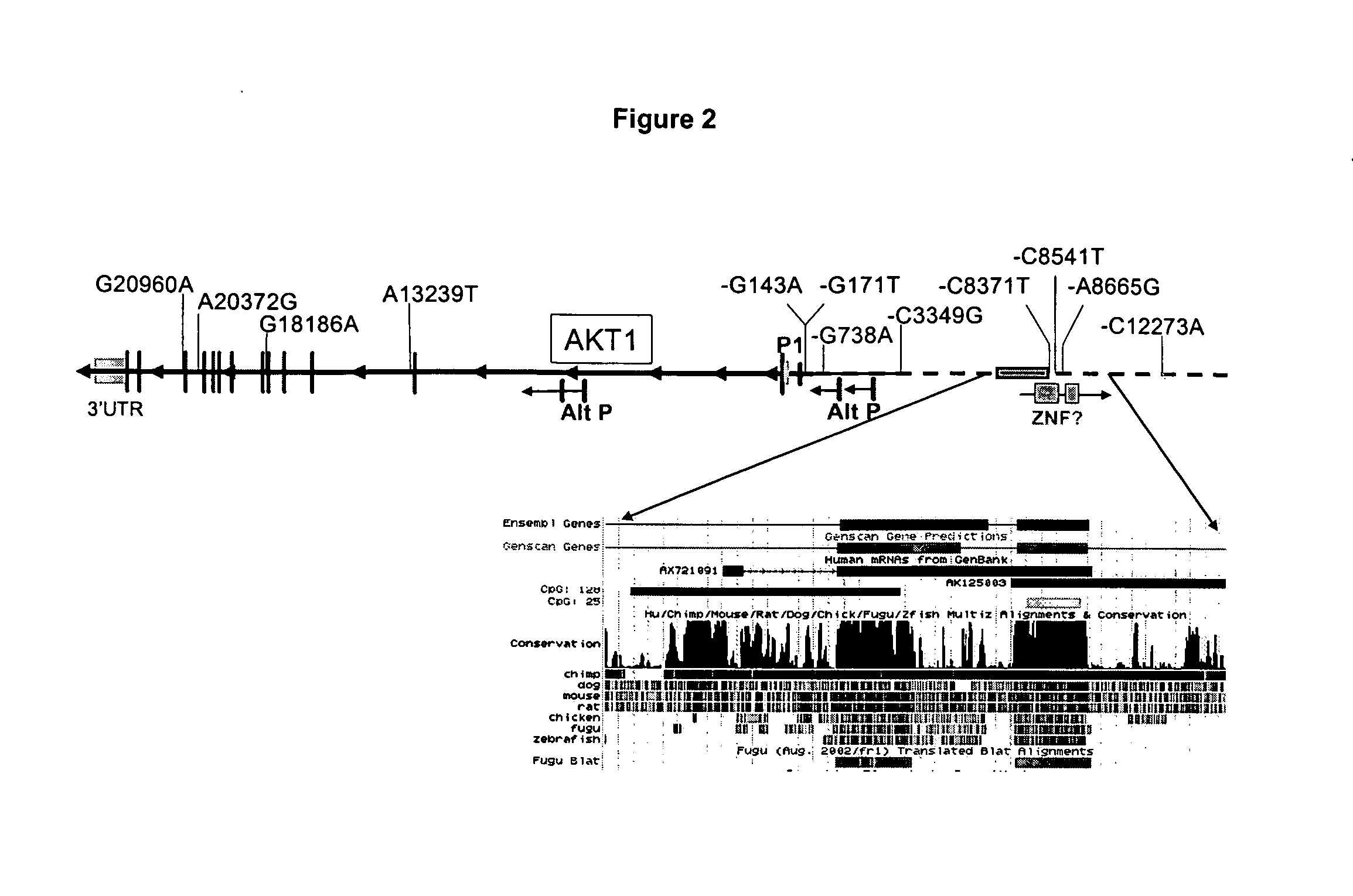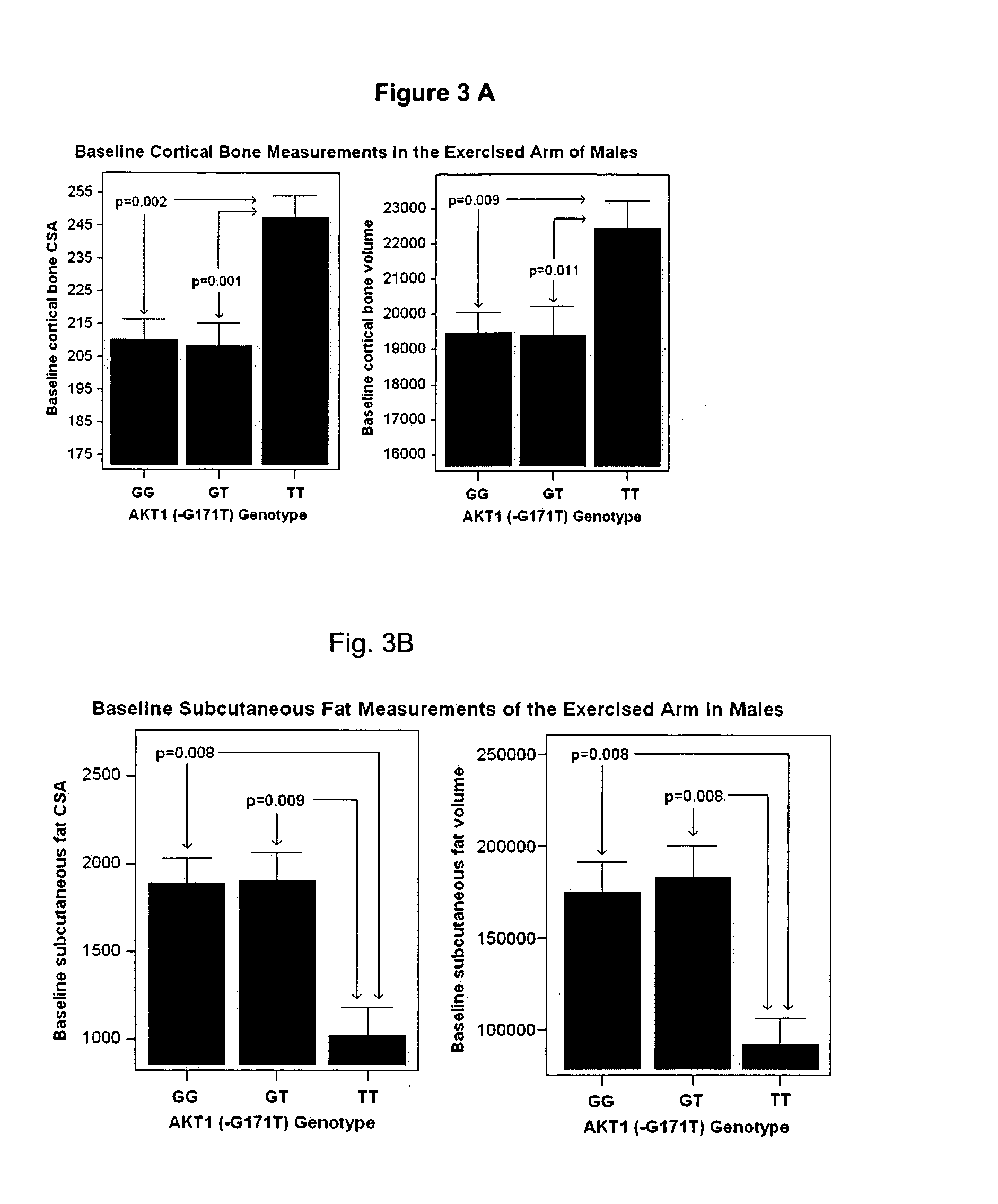Genetic variations (SNPs) adjacent to the AKT1 gene locus, and diagnostic and prognostic uses thereof
a gene locus and gene technology, applied in the field of gene locus adjacent to the akt1 gene locus, can solve the problems of complex genetics of energy balance, adiposity, insulin resistance, and inability to isolate a particular organ easily, and achieve the effects of reducing the potential for type ii diabetes, reducing the area and volume of muscle cross section, and no effect on subcutaneous fat or muscle strength
- Summary
- Abstract
- Description
- Claims
- Application Information
AI Technical Summary
Benefits of technology
Problems solved by technology
Method used
Image
Examples
example 1
The Study Design of the Factors Affecting Muscle Strength and Size (FAMuSS) Program
[0028] We have recently reported the design of the study (7). Briefly, 945 volunteers (18-40 yrs; mean 24±6 yrs; Table 1), were enrolled by one of seven exercise physiology and kinesiology sites. Anthropomorphic data was obtained at study entry, and blood taken for genetic studies. Quantified phenotypes included muscle strength by maximum voluntary contraction (MVC) and one repetition maximum (1 RM), and muscle, bone and fat size by magnetic resonance imaging (MRI) (8). Cross-sectional area (CSA) of the biceps was done using analysis of images at the center of the muscle. In addition, position-corrected semi-automated CSA and volumetric measurements of cortical bone, subcutaneous fat, and entire arm muscle were done for a subset of participants (9).
example 2
Survey of SNPs
[0029] Fifty (50) single nucleotide polymorphisms (SNPs) in candidate genes were selected for analyses of genotype associations with age-, weight- and height-adjusted quantitative phenotypes. Candidate genes were selected from our mRNA expression profiling studies in human volunteers and rats (10,11,12,13), previous genetic association studies (14) (Table 2), and biochemical pathway information (15). SNP discovery was done for 25 of these genes by denaturing high pressure liquid chromatography (DHPLC) of all exons, exon / intron boundaries, and selected 5′ and 3′ UTR and promoter sequences in 96 ethnically diverse individuals (Supplemental Table 1) (16). Any identified polymorphism that showed an allele frequency of >10% in the screening panel was used for genetic association studies in the FAMuSS cohort (Supplemental Table 2) (17).
[0030] QTLs for ciliary neurotrophic factor (CNTF) and muscle strength, angiotensinogen converting enzyme (ACE) and change in muscle streng...
example 3
Another Survey of Candidate Gene SNPs
[0031] Forty four (44) candidate gene SNPs drawn from emerging biochemical pathway data on muscle atrophy and hypertrophy, as well as genes that we have found strongly regulated by aerobic or resistance activity of muscle were tested (Supplemental Table 2). The most significant associations in our study were initially seen with a novel SNP near the AKT1 gene with baseline muscle strength in males (Table 2). AKT1 was considered a strong functional candidate, due to its central role as a signaling molecule in the regulation of muscle remodeling during both atrophic and hypertrophic stimuli (19,20). The SNP was mapped within the 5′ UTR of the AKT1 gene in the 2002 construct of the human genome; however, the 2003 updates of the genome sequence data placed this SNP 12 kb upstream of the first exon. The -C12,273A AKT1 polymorphism showed a relatively high allele frequency in all populations tested (allele: Caucasians 29%; Asians 15%; African-Americans...
PUM
| Property | Measurement | Unit |
|---|---|---|
| volume | aaaaa | aaaaa |
| temperature | aaaaa | aaaaa |
| temperature | aaaaa | aaaaa |
Abstract
Description
Claims
Application Information
 Login to View More
Login to View More - R&D
- Intellectual Property
- Life Sciences
- Materials
- Tech Scout
- Unparalleled Data Quality
- Higher Quality Content
- 60% Fewer Hallucinations
Browse by: Latest US Patents, China's latest patents, Technical Efficacy Thesaurus, Application Domain, Technology Topic, Popular Technical Reports.
© 2025 PatSnap. All rights reserved.Legal|Privacy policy|Modern Slavery Act Transparency Statement|Sitemap|About US| Contact US: help@patsnap.com



